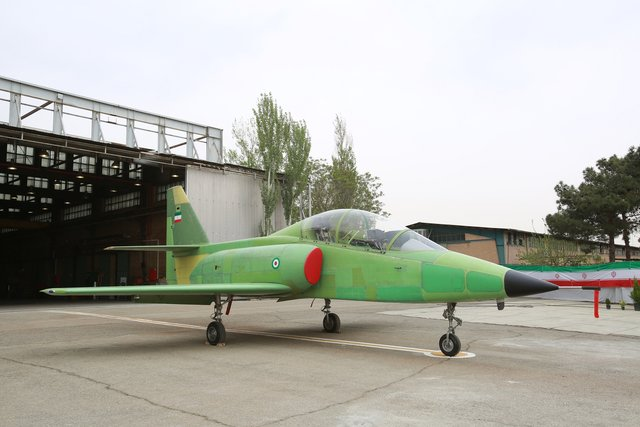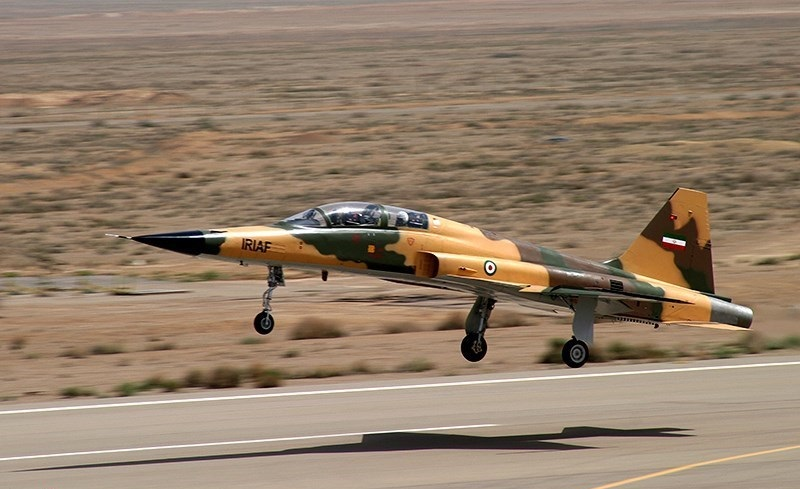Iranian Military, Business Bravado Is All Bluster
By: Daniel Roth and Jordan Steckler
The Iranian regime’s latest display of bombast regarding its Kowsar fighter jet is simply the latest in a string of public relations tricks intentionally designed to paint a bright picture of a dynamic, powerful Iran.
On November 26, Iran kicked off the 9th International Iran Air Show on Kish Island to showcase the country’s purported aviation achievements and to attract foreign purchases of Iranian fighter jets. Ahead of the event, Iran’s state-run Press TV reported that Iran is ready to export indigenously designed and manufactured military aircraft in the near future. The report quoted Head of Iran Aviation Industries Organization (IAIO) Brigadier General Abdoklarim Banitarafi as saying, “We have already taken the necessary steps to export products that we are authorized to sell.” Banitarafi further claimed that Iran had already reached export agreements with China, Russia and Indonesia, ostensibly for the domestically produced Kowsar fighter jet.
Were Banitarafi’s claims true, the sale of Kowsar fighter jets would represent a likely violation of the arms embargo contained in paragraph 6 (b) of Annex B of United Nations Security Council Resolution 2231, which stipulates that all states are to “Take the necessary measures to prevent, except as decided otherwise by the UN Security Council in advance on a case-by-case basis, the supply, sale, or transfer of arms or related materiel from Iran” for the first five years that the Iran nuclear deal is in effect.
In reality, Iran’s claim that it is ready to export indigenous fighter jets and has orders in place unravel under light scrutiny. Russia and China already produce advanced fighter jets and it is inconceivable that Iran would be able to produce anything of value to them. Indonesia does not domestically produce fighter jets but is purchasing them from Russia and South Korea and similarly would be unlikely to benefit from importing Iranian technology.
The fact is that Iran is unable to build planes for itself, let alone export them. The periodic appearances of the Kowsar in the Iranian media underscore this fact. Iran first unveiled the Kowsar in July 2017. Note its appearance:

Source: Defence-Blog
In August 2018, Iranian media again reported on the unveiling and flight testing of an “indigenously produced” Kowsar aircraft, although this time, the plane appeared markedly different:

Source: Wikimedia Commons
Defense analysts were quick to point out that the “Kowsar” was actually a 1970’s era Northrop Grumman F-5F Tiger II serving as the testbed for an upgraded avionics system. The actual Kowsar aircraft was not yet flight-ready due to the impact of sanctions. The effort to publicly showcase the Kowsar and claim it as a fourth generation indigenously produced aircraft, despite clear visual evidence to the contrary, is best understood as a domestic propaganda exercise designed to project military strength and an ability to overcome reinstated sanctions at a time of widespread economic frustration by Iranian citizens directed at the regime.
Undaunted, the Iranian regime in November 2018 announced that it has inaugurated mass production of the Kowsar. Once again, Iran’s claims fell apart under scrutiny. Iranian defense analyst Babak Taghvaee quickly pointed out on Twitter that the photos released by Iran’s Ministry of Defense purporting to show an assembly line of Kowsar production were actually depicting F-5 fuselages built between 2007 and 2011 that were never completed due to a lack of the needed engines and inability to produce said engines domestically. The inauguration of the Kowsar mass production line, timed to coincide with the November 5th reimposition of nuclear-related banking and energy sanctions, was yet another propaganda exercise meant to project strength which actually signaled Iranian weakness.
Iran’s penchant for bluster is not confined to the military domain. Its modus operandi in business is also based to a large extent on boasting about deals that do not exist in an effort to paint a rosy picture of its business climate. Since the JCPOA, United Against Nuclear Iran (UANI) has received many responses from companies and agencies clarifying that many Iran news reports are either exaggerations or fabrications.
The below examples are just a small sample of the kind of fake reports regularly printed by Iran’s fake press.
In July 2017, UANI flagged to London’s Standard Chartered Bank an article published in Iran’s leading English-language business and finance news publication, the Financial Tribune. The report claimed the UK bank was one of “only five foreign lenders licensed to operate in Iran.” Standard Chartered rubbished the claim, confirming instead the bank “has no presence or any operations in Iran… is not active in Iran and has no Iranian business."
The following month, in August 2017, UANI asked the Financial Supervisory Authority of Norway to confirm the veracity or otherwise of claims made in another Financial Tribune report which quoted a Royal Norwegian Embassy official who had reportedly said, “the good news is that banking ties will be established between a number of Norwegian and Iranian banks soon…” The Authority referred us in quick order to the Royal Norwegian Embassy in Tehran, which “officially denied the information, saying it was ‘completely false.’”
Most recently, in October 2018, Swiss transportation specialist Matisa clarified that an article in the notorious sanctioned-designated media outlet PressTV was yet another lie. According to PressTV, the Matisa CEO had confirmed the company “will continue to operate in Iran regardless of US sanctions…” Once again, after UANI contacted the Lausanne firm, Matisa explained this was yet another fabrication. “I can confirm that there is no contract in place between Iran and Matisa,” responded Matisa’s CEO, and the attributed quote was “not what I said and is therefore a fake news.”
So why does all this matter?
Absurd and almost laughable boasts about its ability to make export-grade fighter jets is one thing. But Iran also lies about the billions of dollars and missiles it sends yearly to a host of terrorist groups spreading destruction throughout the Middle East. And it lies about its agents trying to assassinate dissidents on European soil. Iran has adopted a doctrine of proxy warfare ensuring that – even though outmanned, outgunned, and outspent – Tehran still asymmetrically threaten and destabilizes American regional partners. At all times, Iran artfully operates in the “gray zone,” allowing it plausible deniability. As a result, this gives other countries and international organizations just enough of a license to willfully ignore Iran’s malign behavior, to the detriment of international peace and security.
Similarly, Iranian lies also have negative consequences in the business context. Western CEOs read bogus reports of big names doing big deals in Iran and get fed an inaccurate and dangerous portrait of a welcoming and transparent corporate environment. Whereas in reality this could not be farther from the truth – as survey after survey clearly shows.
Perhaps the most consequential lie of all is the one that some members of the global community continue to tell themselves: that Iran can be trusted as a responsible custodian of a nuclear energy program. Iran’s frequently exposed efforts to conceal the extent of weaponization work carried out under its illicit nuclear program are often brushed under the carpet. Iran’s ongoing determination to deceive - whether by extolling the virtues of a non-existent fighter plane or making up quotes attributed to Norwegian bank officials – throws into stark relief why the Islamic Republic can never be trusted with any nuclear capability.
Receive Iran News in Your Inbox.
Eye on Iran is a news summary from United Against Nuclear Iran (UANI), a section 501(c)(3) organization. Eye on Iran is available to subscribers on a daily basis or weekly basis.